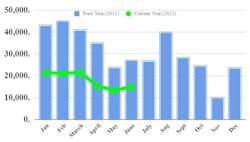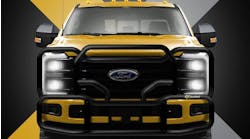Both trucking research firms that track Class 8 production trends monthly have found that heavy-truck orders increased modestly in June over May but that orders for last month were way lower than this time last year.
Both firms, ACT Research and FTR Transportation Intelligence, showed Class 8 orders at around 15,000 units for June, though ACT’s preliminary estimate was a little higher at 15,500 units.
See also: Class 8 orders drop to lowest level since November 2021
FTR found that orders continue to be “subdued,” the research firm said in a July 6 release, as 2023 build slots remain restricted because of limited visibility into future conditions surrounding material costs and lead times. Also, according to FTR, June activity was up 13% from May but down 36% year-over-year—meaning orders were much higher at this time last year.
Class 8 orders have totaled 260,000 units over the last 12 months, according to FTR.
“The June number is positive in the sense that all OEMs entered orders indicating some optimism about improved future supply chain performance," said Charles Roth, commercial vehicles analyst for FTR. “The current order volume still understates the tremendous demand for new trucks.”
Roth added: “OEMs are quickly running out of build slots in 2022. Orders continue to track in a restricted range, with June’s total being in line with the prior three months. OEMs are still working to increase build rates; however, semiconductors, tires, and other key components remain in short supply and continue to limit production."
“The OEMs have a large number of fleet commitments for 2023," he continued. "They are delaying entering these orders until they know how many they will be able to build each month. Supply chain delays continue to constrain build rates.”
He concluded: “As a result of replacement demand, fleets still need a considerable number of new trucks right now. Industry capacity remains extremely tight, resulting in elevated freight rates. The carriers have freight to haul and funds available for new trucks, but OEMs remain limited due to parts shortages. Also, large fleets are now running vehicles beyond their trade-in cycles and need to trade in older trucks, which will result in increased replacement demand in 2023.”
See also: Out-of-sync supply chains are changing trucking
Eric Crawford, ACT VP and senior analyst, also weighed in. “Seasonal adjustment lifts the Class 8 June total to 18,300, representing the strongest seasonally adjusted total since March and in line with the January through May adjusted average of 18,500 units,” Crawford said. “So, despite broader macro uncertainty about Russia/Ukraine, China, interest rates, and potential recession, the prevailing theme in Class 8 remains exceedingly durable: long backlogs and supply chain-constrained production continue to keep new orders trending within a narrow range."
Crawford also noted: “Considering Class 8 backlogs stretch into 2023, that there is still no clear visibility on the easing of all things shortage, and the increasing market jitters about an impending recession, June’s net orders were quite solid.”
About medium-duty, he added, “June demand for medium-duty vehicles was a bright spot. Classes 5-7 orders rose sequentially, and when seasonally adjusted, data represents the third highest seasonally adjusted total of the year, thus far.”
ACT reported that Classes 5-7 net orders were 17,800 units, saying that final order numbers for all classes will be published later this month. The numbers this week from both ACT and FTR are preliminary.





